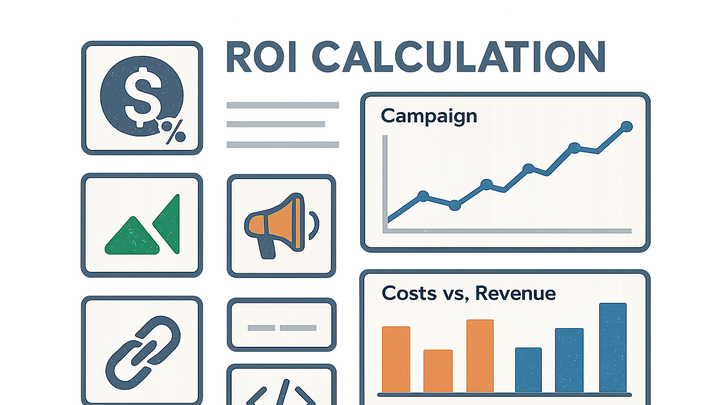Published on 2025-06-29T18:18:03Z
What is Return on Investment (ROI)? Examples for Campaign Tracking & Analytics
Return on Investment (ROI) is a key performance indicator in campaign tracking and analytics that measures the profitability of marketing efforts. It compares the net profit generated by a campaign against the cost of that campaign, expressed as a percentage or ratio. ROI helps marketers understand which channels and campaigns deliver the most value, guiding budget allocation and optimization decisions. A positive ROI indicates that a campaign has earned more than it cost, while a negative ROI signals losses. In digital analytics, ROI analysis often integrates data from tools like Plainsignal for event tracking and UTM Guru for generating consistent campaign tags to ensure accurate revenue attribution.
Return on investment (roi)
ROI measures campaign profitability by comparing net profit to cost, guiding data-driven budget and optimization decisions.
ROI Definition and Formula
This section explains the fundamental concept of ROI in campaign tracking, including the standard formula used to calculate it and key terms like net profit and investment cost.
-
Standard roi formula
ROI is calculated by dividing net profit by campaign cost: (Revenue - Cost) / Cost × 100%. This formula expresses ROI as a percentage, making it easy to compare performance across campaigns.
-
Understanding net profit and investment
Net profit represents total revenue minus all campaign-related expenses, while investment cost includes ad spend, tools, and operational costs. Accurate expense tracking is crucial for reliable ROI calculation.
-
Time frame considerations
Defining the appropriate time frame for ROI analysis ensures consistency. Short-term campaigns may show rapid ROI, while long-term campaigns could impact customer lifetime value.
Why ROI Matters in Campaign Analytics
ROI is a critical metric that helps marketers justify budgets, compare channel efficiency, and demonstrate value to stakeholders. It guides strategic decisions and resource allocation.
-
Budget optimization
By focusing on ROI, marketers can allocate more budget to high-performing campaigns and pause or adjust low-ROI efforts to maximize returns.
-
Performance benchmarking
ROI provides a standardized benchmark across different channels, campaigns, and time periods, enabling fair comparison and trend analysis.
-
Stakeholder reporting
Clear ROI metrics facilitate transparent reporting to executives and clients, showcasing the direct financial impact of marketing activities.
Calculating ROI with Plainsignal and UTM Guru
This section demonstrates how to implement ROI tracking using PlainSignal for analytics data collection and UTM Guru for consistent campaign tagging.
-
Implement plainsignal tracking
Add the PlainSignal script to your website to capture user interactions and conversion events. Example:
<link rel="preconnect" href="//eu.plainsignal.com/" crossorigin /> <script defer data-do="yourwebsitedomain.com" data-id="0GQV1xmtzQQ" data-api="//eu.plainsignal.com" src="//cdn.plainsignal.com/plainsignal-min.js"></script>Use PlainSignal’s dashboard to view revenue and event data linked to specific campaigns.
-
Tag campaigns with utm guru
Generate UTM-tagged URLs using UTM Guru to ensure consistent parameter naming. Organize and save tags in the Chrome extension for future use, improving attribution accuracy.
-
Extract revenue and cost data
Combine PlainSignal analytics outputs with ad platform spend reports. Export data to spreadsheets or BI tools, then calculate ROI by applying the standard formula.
Interpreting and Optimizing ROI
Understanding ROI trends allows marketers to refine strategies, conduct experiments, and enhance overall campaign efficiency.
-
Segmentation analysis
Break down ROI by audience segment, channel, or geography to uncover high-value groups. Tailor messaging and budgets accordingly.
-
A/b testing for improvement
Test variations of creatives, landing pages, or audiences to identify what drives higher ROI. Implement winning variants at scale.
-
Cost reduction strategies
Negotiate ad rates, optimize bidding strategies, and streamline creative production to lower costs while maintaining or increasing revenue.
Common Challenges and Best Practices
Accurate ROI measurement can be hindered by data gaps, attribution issues, and misaligned goals. This section covers pitfalls and recommended approaches.
-
Attribution complexity
Multi-channel user journeys make it hard to assign credit accurately. Consider multi-touch attribution models or incremental lift tests.
-
Data quality and integration
Ensure analytics tools are correctly configured, UTM parameters are consistently applied, and revenue data is imported without discrepancies.
-
Setting clear objectives
Define specific campaign goals and KPIs upfront. Align ROI calculations with business objectives for meaningful insights.
